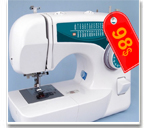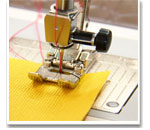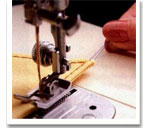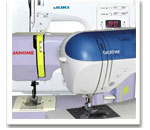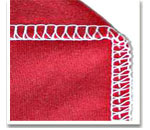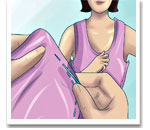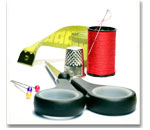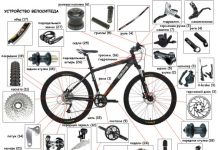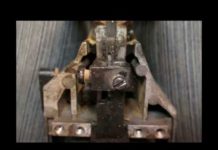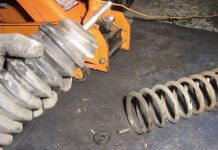In detail: do-it-yourself repair of manual sewing machines from a real master for the site my.housecope.com.
Complex repairs of sewing machines related to the adjustment of units and mechanisms can only be performed by an experienced master. But such repairs are rarely performed, only when a part breaks down at the sewing machine and needs to be replaced with subsequent adjustment.
Most often, the sewing machine begins to "play up" if the rules of its operation, specified in the instructions, are violated or if simple settings and adjustments are not followed.
The main reason leading to a sewing machine malfunction is sewing fabrics that are not intended for this sewing machine model. Sewing a double hem on jeans, replacing a zipper in a leather jacket or bag, etc. - this is the main reason for the appearance of gaps in the stitch, thread breakage, needle breakage. Sometimes this can even lead to a breakdown of the sewing machine, subsequent complex repairs associated with the replacement of parts.
This article provides basic recommendations on how to set up and perform a simple DIY repair of a sewing machine.
Oddly enough, but it is the needle that is the most important part of the machine. During its “life” it makes thousands of punctures in the fabric and is not always light and thin, so sooner or later the needle point becomes dull, and the needle itself bends. And if at least once the needle hits the metal part of the machine body, the tip will bend in the literal and figurative sense of the word.
However, do we pay attention to this? The needle seems to be intact, so everything is fine. But take a magnifying glass and look at its point, its blade will be bent to one side. How would such a point pierce the tissue? There is only one way - to break it.
| Video (click to play). |
Now let's see how such a needle will form a stitch.
The thread passing through the eye of the needle will catch on the curved point and “slow down”, creating excess upper thread in the stitch. Here is the first reason the loops appear in the stitching. Moreover, a curved point will cause periodic thread breakage, especially in difficult to sew areas, when the upper thread is extremely stretched.
It turns out that sometimes the whole repair of a sewing machine consists only in replacing the needle.
Treat the needle with great care. Even if it outwardly has no blade defects and is not bent, try to change them more often anyway.
You do not need to throw out the used needles, as there are situations when the needles break one after the other, for example, when sewing a leather bag. Then remember about the jar with old needles.
Another reason for adjusting the sewing machine, especially the old manual machines such as Singer or Podolsk, is the incorrect insertion of the needle into the needle bar. The needle blade (fig. B) should be on the side of the hook nose. Remove the stitch plate and see if this is the case if the machine suddenly begins to twist and break the thread.
It often happens that a seamstress installs a needle from an industrial sewing machine into a household sewing machine. It is impossible to confuse a household needle with an industrial needle. A household needle has a special cut on the flask (Fig. B). But, nevertheless, it is the industrial types of needles that are installed. This absolutely should not be done. Firstly, you break the gap between the hook nose and the needle blade, hence the gaps in the stitches, and secondly, you risk damaging the sewing machine hook. Some commercial needles are noticeably longer than household needles and may touch the surface of the hook, scratch it or even damage the hook.
Figure (A) shows a diagram of how to check the curvature of the needle.Externally, the needle cannot be determined whether it is a curve or not, and if you put it on the glass (2), you can easily check the gap (1). Please note that an uneven, bent needle will cause gaps in the stitching and will break sooner or later.
To make the sewing machine “more confident” to work with fabrics that are difficult to sew, such as knitwear, stretch, thin natural and artificial leather, denim, needles are produced for sewing just such fabrics and materials. They have a special point shape and make it easier for the thread to pass through the fabric, almost eliminating skipped stitches and looping of the upper thread.
See Home sewing machine needles.
The thread looping in the stitching, as well as the characteristic knock during their operation, is perhaps the main difference between sewing machines with a zigzag, such as Chaika, Podolskaya 142 of all models. In short, the looping in the stitching occurs due to the uneven tension of the thread along its path: a broken compensation spring, rusty sole of the foot, the shuttle is incorrectly set, etc. However, it is impossible to set many parameters yourself without experience. Therefore, if you have a poor quality stitch, pay attention first of all to the condition of the needle, to the tension of the lower thread in the bobbin case, and whether the upper thread tensioner is working properly. Very often, children like to disassemble and assemble it, and after such a repair, the machine stops working.
It is sometimes necessary to repair the sewing machine Chaika quite often, and this is not due to the breakdown of parts, the parts are just very strong, but with the misalignment of the interaction of some units of the sewing machine, mainly the shuttle move.
Almost all of these tips for repairing a sewing machine Chaika can be used for other models of household machines.
First of all, check the nose of the shuttle with a magnifying glass, it should not have any chipping or rusty spots. If there are jags, they must be removed with a small file and polished to a shine, otherwise the thread will constantly linger behind the file marks, and loops will appear below. Only this must be done carefully so as not to blunt the tip of the shuttle nose.
Sometimes the bobbin (the bobbin thread is wound around it) can cause repairs to the sewing machine. Yes, it is repair, since an inexperienced "master" often disassembles and assembles all the units, when it is enough to simply replace the old metal bobbin with a new plastic one. If the edges of the metal bobbin are jagged and the bobbin case itself is clogged with thread fleece, the bobbin thread will come out in jerks and the upper thread in the stitching will periodically loop from below.
Often the reason for contacting a sewing machine repairman is that the upper thread is poorly regulated. You are tightening it almost completely, but the tension is still too weak. Look, perhaps, between the tensioner plates, thread fluff has accumulated, which prevents the washers from fully squeezing. The fastening of the tensioner (Chaika) may have loosened.
But still, most often, sewing machines such as the Seagull have a malfunction in the parameters of the shuttle and the needle. This is a complex type of repairing a sewing machine, more precisely adjustments, but for general information it is advisable to know the main reason due to which all the "troubles" of sewing machines occur.
The most common cause of a sewing machine malfunction is the upper thread. Thread breakage, looping in a stitch, uneven stitching, skips, etc. This often depends on the upper thread tensioner.
It is the fastening of the tension regulator (Seagull) that most often causes its poor performance. The plastic body is pressed under the pressure of the screw and over time the tensioner starts to stagger, or even completely "falls out" of the body.
In this photo, arrows indicate the attachment of the needle bar and tensioner.When sewing rough fabrics, intersecting seams on leather goods, and especially when hemming jeans, the needle bar may move upward with the needle.
Loosen the screw slightly and adjust its position, making sure that the blade and needle groove are in the correct position in relation to the hook (not turning left or right).
For details on how to disassemble and assemble the sewing machine tensioner, see the article "The device of the sewing machine tensioner Chaika".
Adjusting the shuttle mechanism of sewing machines performing zigzag stitching by Chaika, Podolsk, Veritas and others implies setting the position of the looper point above the needle eye by 1.2 (3) mm at the moment the looper point approaches the needle. This parameter is checked when the sewing machine sews not only the straight stitch, but also the left and right needle drop (when sewing the zigzag stitch).
The point of the shuttle must at the same time pass almost closely to the blade of the needle - this is the second condition that allows you to form a stitch without gaps.
In this photo, the arrow indicates the fastening of the shuttle shaft. Loosen the screw with a 10-point wrench, and holding the handwheel by hand, you can turn the shaft (together with the shuttle stroke) by adjusting the position of the hook nose in relation to the needle.
However, these are not all of the parameters for adjusting the interaction of the hook nose and the needle. There is such a parameter as the timeliness of the approach of the shuttle nose to the needle, namely at the moment when the needle starts to rise. The needle drops to the lowest point, and when raised by 1.8-2.0 mm, it should meet the nose of the shuttle, the shuttle removes the loop from the needle and wraps around itself.
But that's not all. For sewing machines performing a zigzag stitch, there is such a thing as right and left needle prick. With the left and right prick of the needle, the nose of the shuttle should “confidently” remove the loop formed above the eye of the needle. It should run slightly above the eye of the needle, but less than the distance of the eye of the needle itself, about 1 mm.
However, such adjustments are often not required to be performed, it is enough just to check with a magnifying glass how the shuttle interacts with the needle and make sure that repairs, adjusting the sewing machine are not needed, and look for another reason. For example, change the threads, thread them correctly, change the needle, clean the shuttle from dust and fleece, etc.
To make it easier for you to repair the sewing machine, disassemble the shuttle move and study its device. Observe how the stitch is formed when the stitch plate is removed. At the same time, check all the shuttle settings described above. See also How the sewing hook works.
The settings above can be used as a guide if you decide to repair your sewing machine yourself. As a rule, the machine will work normally with such gaps, but if you need to sew knitted fabrics that are too thin (silk) or, on the contrary, thickened fabrics, you need a more accurate adjustment of these parameters, which can only be set by the master.
In many cases, sewing machine repairs will not be necessary as long as the sewing machine is kept clean and lubricated periodically. If a seamstress takes care of her machine, then, therefore, she will protect it from overloading during work, not give it into the “wrong” hands, which means that the sewing machine will break less often.
After prolonged operation, clean the bobbin compartment and other accessible places from dust, fleece, oil stains. The shuttle itself and the shuttle mechanism should be periodically cleaned with a stiff hair brush. It is advisable to lubricate the machine at least once every six months, and after lubricating it, run it “idle” a little, especially if the machine is not used for a long time. During operation, the oil heats up slightly and penetrates better into units and places of friction.
It is better to draw machine oil into a medical syringe and bury it in small drops in accessible places where there is friction of metal parts.
The big enemy of all mechanisms is dirt and rust, try to keep the car in a cool, dry place. If the machine will not be used for a long time, protect it from dust, otherwise the oil from the dust will harden, and the machine will turn tightly, or even jam. This case is considered in the article Podolsk Manual Sewing Machine.
In this article, we will figure out whether such a combination is possible - "an inexpensive and good machine" and how an inexpensive sewing machine that costs 3-4 thousand rubles differs from a machine that costs 30 thousand.
Many who tried to sew knitwear on an ordinary sewing machine noticed that the machine often refuses to make a beautiful and even stitch. There are gaps in the knitted stitching, the lower thread loops and sometimes breaks. Why is this happening and how can you fix it?
The coverlock is a modern and versatile machine that can overcast fabrics, sew cover stitches and even stitch parts like a regular sewing machine. But it is impossible to repair such a sewing machine with your own hands, you must definitely contact the service center.
Sometimes it is required to make a perfectly even decorative stitch on the product, but you cannot draw a line with chalk - traces will remain, and there is not enough experience to scribble "by eye". Simple tips on how to sew on “difficult” areas.
For those who rarely sew simple products or occasionally perform minor repairs on clothes, you can buy an inexpensive economy-class sewing machine. It performs almost all operations, is easy to operate, and most importantly, for such a machine, it will be cheaper to build repairs if suddenly it is needed.
The overlock is much more complex than sewing machines. It is almost impossible to repair an overlock without special knowledge and skills. However, repair or adjustment is not always required, sometimes it is enough just to adjust the thread tension and it will again overcast the fabric with high quality.
How to sew a dress with your own hands. Technology and sequence of sewing dresses for beginners.
How to make a pattern, what tools are needed for this. These and many other tips for beginners.
Sewing machines do not lose their popularity even in the twenty-first century. Those who were born in the Soviet era remember that from childhood girls were taught to sew various things, from gloves to jackets and coats.
During the Soviet era, most people did their own sewing machine repairs. Even today, those who attend sewing and sewing courses understand that it is better to repair a sewing machine on their own than to take it to a service center:
- Firstly, companies that repair sewing machines demand quite a lot of money from their customers for the services they provide.
- Secondly, the device of even modern machines can be figured out in a matter of hours, one should only carefully approach this issue, and in the future this will allow repairing sewing machines without involving third parties.
Let's take a look at the basic rules for operating sewing machines:
- Sewing equipment should not be placed near batteries or heaters. But at the same time, it should be in a dry room, in which there are no signs of dampness;
- Before starting work, it is necessary to select the necessary materials and tools, needles and threads that will be needed in the process of work;
- Before you start sewing, you need to make sure that the needle and thread guide are in the up position;
- Remember that the sewing machine must be helped at the time of sewing by pulling the fabric towards you;
- After the sewing work is finished, raise the presser foot and pull out the fabric. Next, cut the thread, having found a free end in advance, the length of which will be equal to a maximum of seven, but at least five centimeters.
There are rules and they must be followed. The use of quality materials and additional tools minimizes the occurrence of problems and malfunctions when working with sewing machines. Therefore, the following reasons, which led to malfunctions, are the most common:
- Broken thread. Breakage can occur both with the upper and lower threads. In the first case, the problem is associated with the selection of low-quality threads or the size of the needle is not correctly selected. In the second case, the problem of a malfunctioning sewing machine may be associated with irregularities, the presence of burrs in the bobbins, and with improper winding of the thread.
- Problems with advancing the fabric. If such a problem arises, you need to carefully look at the position of the teeth. If they are lifted up or lowered to the bottom, then it is required to bring them to a normal state;
- Cutting through the fabric. If such a problem arises, in order to fix the machine, we need to reduce the pressure of the presser foot, and check the condition of the needle, it may be too dull.
The above problems are not serious, and are eliminated in a matter of minutes. But there are some types of problems that do not occur very often. Therefore, repairing sewing machines with your own hands, if they occur, will take a lot of time.
The most difficult, most serious breakdown should be considered the appearance of a knock when the sewing machine is running. To solve this problem, it is necessary to pull the flywheel several times, and do this in accordance with the axial direction of the machine.
In order to repair the sewing machine, it must be disassembled. We disassemble the sewing machine in the following sequence:
- Remove RP (manual drive). It is necessary to remember its location, this will allow you to subsequently assemble a sewing machine in a short period of time;
- Unscrew the stopper from the nut, which is a classic screw. It is under a manual drive, at the time of assembly it must be screwed back to its original location;
- Remove flywheel. This must be done carefully, avoiding damage to it, in the event of a malfunction of the flywheel after assembling the machine, you need to see if everything is in order with it;
- Remove the bobbin that looks like a taper. It is located below, after the flywheel. Finding it will not be difficult;
- Remove the bushing from the shaft base;
- Slide a tin washer onto the shaft. It is very simple to make such a washer, just cut out the bottom of a tin can.
The washer in 40% of cases is a guarantee of high-quality performance of work using a sewing machine. Sometimes adding it to the typewriter is enough to solve the problem, but this does not always happen. When adjusting the operation of sewing machines, in 60-70% of cases, it is necessary to turn the rail 180 degrees.
The needles are the basic elements that make the sewing machine work. Its further work depends on which needle is chosen. If a defective needle is picked up, then the occurrence of the above problems is not a rare case, because the needle is the basis, and without it it is impossible to sew a single thing.
Therefore, when choosing a needle, you must carefully consider its size and thickness. You also need to check the numbering of the needle if any complex sewing work is being carried out, otherwise it may happen that the thing does not turn out the way you imagined it earlier.
There is another problem in which the wrong choice of a needle can lead to stretching and damage to the tissue. If the needle is too thick and the fabric is thin, then you cannot use the needle with such fabric, otherwise it will break.
Using too thick fabric with a small needle may break the needle. In order to sew something from a compacted fabric, you need to choose a thicker needle, if it is not available at home, then go to the store and purchase it. Before doing this, measure the thickness of the fabric in advance - this will allow you to choose a needle in the store in a shorter time, you will need to tell the seller the thickness of the fabric, and he will independently select the needle of the size you need.
What are you going to fix in the sewing machine? With regards to products from the time of Stalin, nothing ... It works to this day. Modern breakdowns will torment, a bunch of settings get confused, requiring correction to get the desired result. We have nothing against progress, but historians consider a society preoccupied with consumption as an intermediate stage. Like a tax on bridges erected by medieval feudal lords to impose tribute on pedestrians. It got to insanity: buildings were built out of the blue for profit. Low-quality things are akin to ancient savagery and will become a thing of the past. Do-it-yourself sewing machine repair is a pleasure! The weak half is strong in needlework, when a strong helper is at home.
In 1953, Clifford Simak's story, The Ring Around the Sun, was released. The meaning of the plot: in orbit there are countless myriads of Earths located in parallel universes. Events developed against the backdrop of the curious invention of the eternal light bulb. Then the ever-mobiles appeared. Clifford described the fall of the consumer society, the goods were bought once, used a whole life, remember Stalin ... A revolution happened, working people, fearing to lose their jobs, began to destroy modernized factories, the most interesting thing was built by people moving between dimensions. In a ring around the sun.
Until 1829, the inventions of the sewing machine field would be called unsuccessful, although Leonardo da Vinci created the first drawings that would be equal to future generations. During the era of manufactories, the French tailor Timonier created a wooden model, which they immediately began to copy and reproduce. One replaced several apprentices. There were massive demonstrations of artisans who saw a threat to existence (I wonder what the rulers will do, if scientists create a computer that makes decisions, can grimace, they will immediately destroy it?). The matter went far: 200 local tailors destroyed the workshop of new mechanical sewing machines, Timonye had to flee, fearing for the safety of his life. Not the first time: the inventor of the loom suffered a similar fate.
The surviving fruits of the technological revolution
During his life, Timonier created a billion modifications of the sewing machine. Some technical solutions are still used by household, industrial modifications. 300 stitches every minute were made by machines, today's electric models are capable of producing three times more. For 200 years! The frequency of computer processors doubles every two to three years (growth has slowed down since 2010). Timonier's sewing machine worked with silk and other delicate fabrics.
In parallel, in 1834, Walter Hunt invented a model with a shuttle, reminiscent of modern ones. By 1848 Elios Howe created the first sewing machine containing the features of the present. The fabric feeder appears. The sewing machine is equipped with a horizontal curved needle, makes 300 stitches per minute, replaces three tailors. The workers of the USA revolted and destroyed the shop. The inventor had to flee, fearing for his life. The last stitch was probably made by Singer. Gives the needle a vertical motion, introducing the modern look of the toothed strips pressed by the foot. In 1900, a workshop in Podolsk was built, where 5000 people worked for the October Revolution. Initially, Singer parts were imported from the United States, then they began to be manufactured in Russia.
Brother, Janome, Bernina, and other brands of sewing machines appeared. People are afraid of change, but change is inevitable. Revolutionaries hinder progress.Imagine if inventors stopped producing promising technologies. Humanity will continue to explore caves and trees instead of cities with multi-storey buildings.
I immediately remembered modern economical light bulbs. I had a chance to talk to an old sewing machine, it became clear, probably, since the time of invention, the technology retained the principle, settings. The quality of the parts was not right. Although they discovered smooth surfaces (nanotechnology), they created strong alloys. A main shaft with a crankshaft is introduced inside. Moving parts of the sewing machine work from it. What will be stated below affects the repair of hand sewing machines:
- The needle is directly connected to the shaft. To ensure the forward movement up and down, a crankshaft is held inside. An eyelet is made in the needle where the thread is threaded. When moving down, the fabric is pierced, the loop is captured by the shuttle moving in a circle, in one direction, in the other. For 1 revolution of the main shaft it manages to run back and forth.
- The shuttle is driven by a separate shaft connected to the main one by means of a knee. The phase of movement is regulated by a screw. You can rotate the auxiliary shaft relative to the main one. Synchronization of movement is achieved. Let's discuss repairing the sewing machine shuttle.
- The third component, which ensures the movement of the fabric along the seam in the desired direction, are the toothed strips. Made of steel, they move like the legs of a person when walking. They go down, go forward, go up, go back. There is one cycle per stitch.
It is important to correctly set the vertical position of the toothed strips. When the needle plunges into the fabric, the top edges of the teeth will be level with the sewing machine table.
Unlike other devices, the toothed strips are driven by two shafts. One is responsible for horizontal movement, the other for vertical movement. The adjustment method is the same. A screwed screw on the axis of the corresponding shaft, which changes the position of the segment relative to the phase of the main shaft. Correct adjustment of the toothed strips is achieved.
It is important to ensure the correct position of the needle in relation to the hook. Remember three landmarks to look up to. Please note: for modern models, the old ones are arranged differently, and adjustment is required once every hundred years (twice since the invention)!
- In the lower position, the eye of the needle is 4 - 6 mm below the nose of the vertical hook.
- The nose of the hook is compared with the edge of the needle - the distance from the top edge of the nose-hole is 1 mm.
- When the top edge of the tab is aligned with the bottom edge of the hook nose, the hook nose should extend 1 mm beyond the needle.
Approximate guidelines, you can use it, decorating the horizon, the need to repair sewing machines with your own hands.
Wise mom instructs daughter correctly
Repairing the electric sewing machine is not the only thing to do. The heel clamp is adjusted so that the fabric stops crawling. Made with a special screw. There is a spring inside, so the setting can be approximate, it will rarely be required. This applies to stitch lengths. For thin fabrics, more frequent are recommended, for thick fabrics, rare. In mechanical machines, the reverse is often turned on with a handle, it is inconvenient when you need to sew a patch, it is better to forget about the inscriptions altogether.
It is much more important to set the upper and lower thread tension correctly. If done incorrectly, a number of unpleasant effects will occur when using a sewing machine:
- When the upper thread tension is loosened, there will be loops at the bottom of the seam. It is corrected by a special adjustment mechanism until the result is satisfactory. You can loosen the bobbin thread with the bobbin screw. It is important to know: too little tension is not allowed - the seam will not work at all - too strong - the thread may break. The last two cases are malfunctions, take note.
- Pull the upper thread too tight - the fabric begins to pull together. Seen from jagged, billowing edges.You can release the upper thread, pull the lower one. Please note that you should not be too zealous. The pulled thread breaks, as mentioned above.

